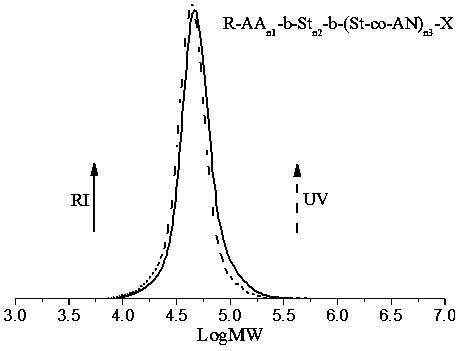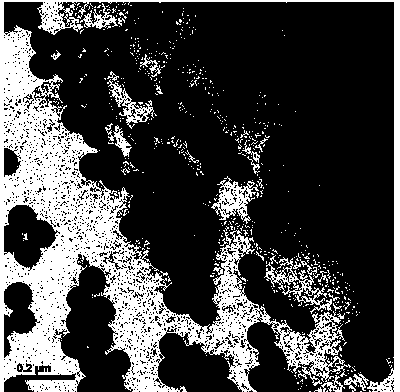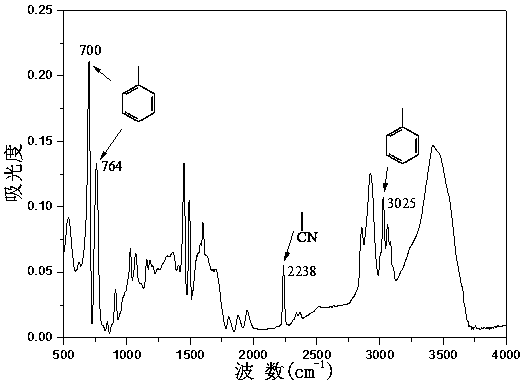Poly(methyl) crylic acid-b-styrene-b-styrene/acrylonitrile) segmented copolymer latex and preparation method thereof
A technology of block copolymer and styrene, applied in the field of block copolymer materials, can solve the problems of inability to synthesize high molecular weight polymers and block copolymers well, the final conversion rate is only 66.7%, and the molecular weight of products is out of control. , to achieve the effect of easy pipeline transportation and continuous production, controllable molecular weight growth, and wide range of monomer composition
- Summary
- Abstract
- Description
- Claims
- Application Information
AI Technical Summary
Problems solved by technology
Method used
Image
Examples
Embodiment 1
[0041] Embodiment 1 (R-AA n1 -b-St n2 -b-(St-co-AN) n3 -X, wherein the molecular weight of the St-co-AN random copolymer is 30K, and the ratio of the monomer mass of St to AN is 3:1):
[0042] 1.7 parts by weight of amphiphilic macromolecular reversible addition-fragmentation chain transfer reagent (1) was stirred and dissolved in 80 parts by weight of water to form a uniform water phase, and then mixed with an oil phase composed of 15 parts by weight of St and 5 parts by weight of AN Pour into reactor and stir to mix. Raise the reaction temperature to 70°C, keep stirring, add 0.04 parts by weight of potassium persulfate after passing nitrogen for 5 minutes, and polymerize for 1 hour to obtain R-AA n1 -b-St n2 -b-(St-co-AN) n3 -X block copolymer latex.
[0043] As can be seen from the data in Table 1, there is a certain deviation between the measured value of the molecular weight of the polymer and the design value, which may be caused by the polarity difference between ...
Embodiment 2
[0046] Embodiment 2 (R-AA n1 -b-St n2 -b-(St-co-AN) n3 -X, wherein the molecular weight of the St-co-AN random copolymer is 30K, and the ratio of the monomer mass of St to AN is 3:1):
[0047] 1.7 parts by weight of amphiphilic macromolecular reversible addition-fragmentation chain transfer reagent (1) was stirred and dissolved in 80 parts by weight of water to form a uniform water phase, and then mixed with an oil phase composed of 15 parts by weight of St and 5 parts by weight of AN Pour into reactor and stir to mix. Raise the reaction temperature to 60°C, keep stirring, add 0.04 parts by weight of ammonium persulfate after passing nitrogen for 30 minutes, and polymerize for 2 hours to obtain R-AA n1 -b-St n2 -b-(St-co-AN) n3 -X block copolymer latex.
Embodiment 3
[0048] Embodiment 3 (R-AA n1 -b-St n2 -b-(St-co-AN) n3 -X, wherein the molecular weight of the St-co-AN random copolymer is 30K, and the ratio of the monomer mass of St to AN is 3:1):
[0049] 1.7 parts by weight of amphiphilic macromolecular reversible addition-fragmentation chain transfer reagent (1) was stirred and dissolved in 80 parts by weight of water to form a uniform water phase, and then mixed with an oil phase composed of 15 parts by weight of St and 5 parts by weight of AN Pour into reactor and stir to mix. Raise the reaction temperature to 70°C, keep stirring, add 0.04 parts by weight of 4,4'-azobis(4-cyanovaleric acid) after 30 minutes of nitrogen gas, and polymerize for 1 hour to obtain R-AA n1 -b-St n2 -b-(St-co-AN) n3 -X block copolymer latex.
PUM
| Property | Measurement | Unit |
|---|---|---|
| The average diameter | aaaaa | aaaaa |
Abstract
Description
Claims
Application Information
 Login to View More
Login to View More - Generate Ideas
- Intellectual Property
- Life Sciences
- Materials
- Tech Scout
- Unparalleled Data Quality
- Higher Quality Content
- 60% Fewer Hallucinations
Browse by: Latest US Patents, China's latest patents, Technical Efficacy Thesaurus, Application Domain, Technology Topic, Popular Technical Reports.
© 2025 PatSnap. All rights reserved.Legal|Privacy policy|Modern Slavery Act Transparency Statement|Sitemap|About US| Contact US: help@patsnap.com



